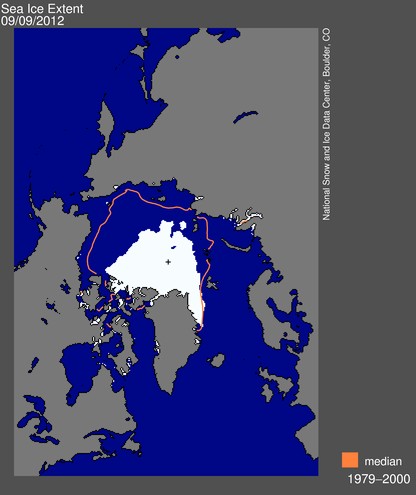ANCHORAGE, Alaska (AP) — Royal Dutch Shell on Monday was moving its drill ship off a prospect in the Chukchi Sea, a day after drilling began 70 miles off the Alaska coast because sea ice was moving toward the vessel.
Shell Alaska spokesman Curtis Smith tells The Associated Press that drilling was stopped for safety reasons.
“As a precautionary measure and in accordance with our approved Chukchi Sea Ice Management Plan, Shell has made the decision to temporarily move off the Burger-A well to avoid potentially encroaching sea ice,” he said by email. “Once the ice moves on, the Noble Discoverer will re-connect to anchors and continue drilling.”
Shell officials on Sunday were monitoring ice measuring 30 miles long and 12 miles wide about 105 miles away from the drill ship, Smith said by phone.
http://www.seattlepi.com/
This is of course impossible, because the experts in Boulder, Colorado say that there isn’t any ice in the Chukchi Sea
h/t to Eric Simpson



By “experts in Boulder” are you referring to the Club of Rome mutant progeny, Kevin Trenberth? Or a subordinate of the deceitful democrat, Tom Karl?
Or maybe an associate of the crypto-communist, Jane Lubchenco?
Colour me amazed. A few months ago I suggested they might have trouble. Wish I could find that post.
“once the ice moves on…”
Moves to where, exactly? Antarctica?
Good luck with that.
NOAA is taking a certain percentage of ice as “no ice” and is not saying what that percentage is. There are likely high and low values of what that percentage is, that would gag you to know the truth
Those graphs ect. depict areas of 15% or more covered by sea ice. As only 10% of floating sea ice is visible on the surface and detectable , it really is a load of nonsensical statistics. Suppose an area of 200,000 sq. miles had 16 %=32,000 sq. miles ;then that sea ice was all blown together. You would then have 32,000 sq. miles of 100% cover and 168,000 0% cover. On the other hand -suppose the ice was 40 ft thick on average then spread out so that it was only 5 ft. thick- you would have near enough 100% ice cover.
We all know that those passive microwaves don’t lie, Steve. Of course, unless there’s a boat [like Royal Shell’s] or a plane flying over the “ice-less” sea, we can’t refute their superior technology. Let’s see, 360 sq. mi. for this chunk of ice would ‘convert’ about 6,000 sq. km. of ocean to 15% ice-covered area. Does Royal Shell see any more real ice around there? Maybe we’ve found the “black ice” missing from the NSIDC charts?
I wonder how many of these 30 mile long by 12 miles wide ice thingys are out there but not able to be seen by the fancy satellites 😉
My happy daydream is for Greenpiece to send Rainbow Warrior up there to jump aboard the rig in protest – to be shipwrecked by an iceberg
lol
Except for that one big piece…
Shell isn’t the only one.
http://fuelfix.com/blog/2012/09/04/statoil-delays-start-of-chukchi-drilling-until-at-least-2015/
More missing ice found in Chukchi sea…
“Lisanne Aerts, principal researcher for the Chukchi survey, said by email the killer whales were cruising close to the pack ice edge”
http://newsminer.com/view/full_story/20102964/article-Whale-surveys-spot-killer-whales-in-Alaska-Arctic?instance=home_news_window_left_bullets
One more…. how can heavy icebreakers be in short supply? There is no heavy ice, right Julienne?
” so-called “heavy” icebreakers, of which each country currently possesses only one in operation (although the US Coast Guard possesses three, the USCGS Healy is the only one in operation, with the Polar Sea “inactive”, and the Polar Star in the process of a retro-fit), are in short supply”
http://www.geopoliticalmonitor.com/reluctant-allies-canada-the-us-and-the-northwest-passage-4725/
“The ice varies in thickness, he said, but at its thickest is 25 meters, or about 82 feet. It was moving at 0.5 knots, or less than 1 mph.”
This is pack ice, right? Twenty five meters thick, crap on a cracker I had no idea it got that thick.
http://bit.ly/RPbRNW
Just goes to show- say on average that ice flow is 40 ft thick. Spread it out so that it is 5 ft thick and the area goes to 2880 sq. miles which is over 1% of the Chukchi Sea…